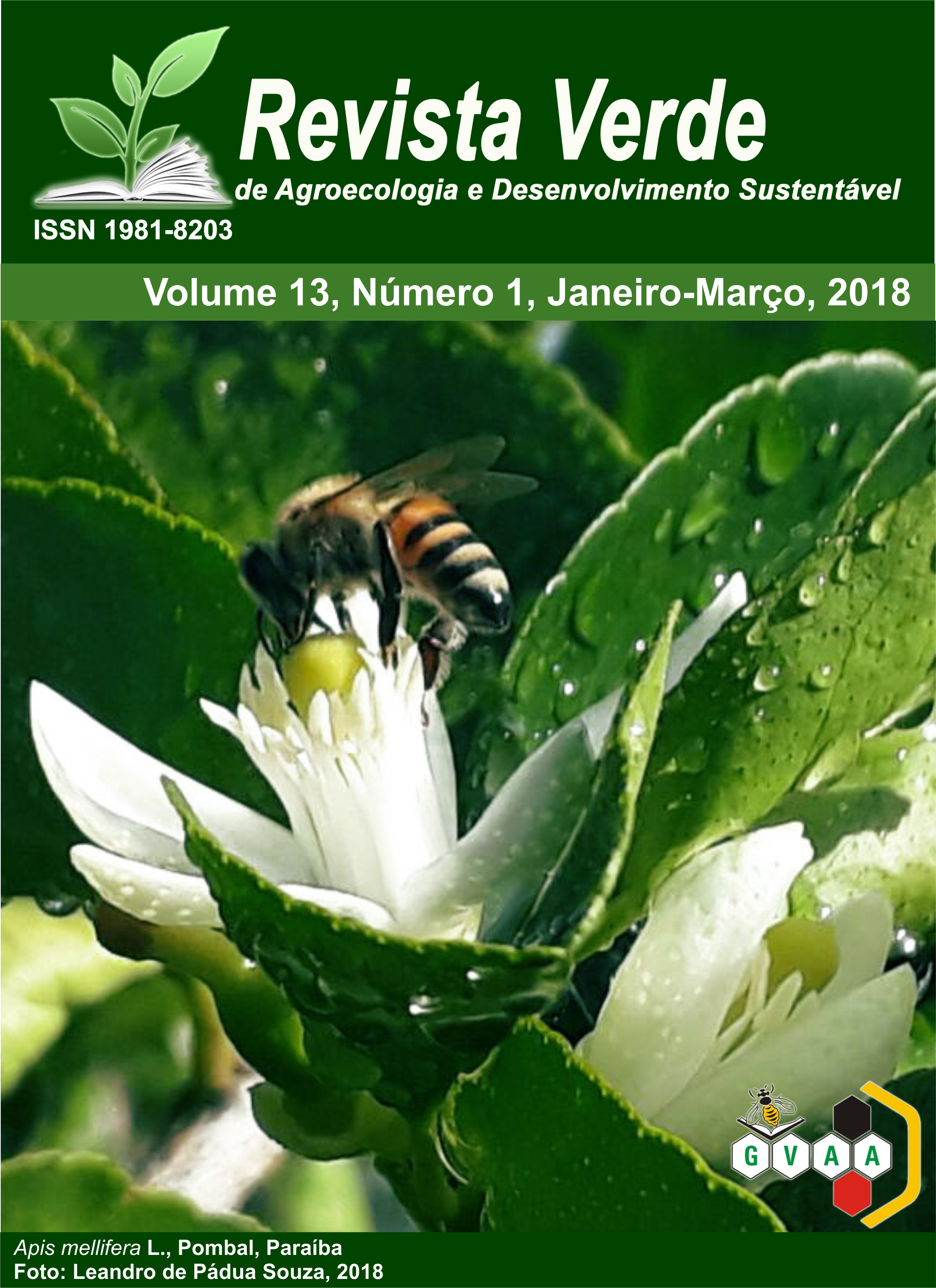In vitro toxic activity of Croton heliotropiifolius Kunth (Euphorbiaceae)
DOI:
https://doi.org/10.18378/rvads.v13i1.4917Keywords:
Toxicity, Methanolic extract, Artemia salina.Abstract
Often found in some Brazilian biomas as caatinga, brejo, restinga and cerrado, the velame, Croton heliotropiifolius Kunth, is popularly known for its medicinal properties used in stomach ache, gastric reflux, vomiting, bloody diarrhea and to reduce fever. In addition to the pharmacological properties, its essential oil has larvicidal activity against Aedes aegypti, as well as the ethanol extract showed significant insecticidal activity against Sitophilus zeamais. This study aimed at evaluating the toxicity of preliminary methanolic extract of Croton heliotropiifolius Kunth on Artemia salina larvae. The bioassay was carried out at concentrations of 50 µg/ml, 100 µg/ml, 250 µg/ml, 500 µg/ml, 750 µg/ml, 1000 µg/ml of methanolic extract of leaves. The extract studied showed a moderate toxicity to Artemia salina, with LC 50 values in the range of 637,29 µg/mL.Downloads
References
ALBUQUERQUE, U. P,; OLIVEIRA, R. F. Is the use-impact on native Caatinga species in Brazil reduced by the high species richness of medicinal plants? Jornal of Ethnopharmacology, v.113, p.156- 170, 2007.
AYO, J. O.; SINKALU, V. O. Effects of ascorbic acid on diurnal variations in rectal temperature of Shaver Brown pullets during the hot-dry season. International Journal Poultry Science v.6, n.9, p.642-646, 2007.
BLAAUBOER, B. J. Biokinetic and toxicodynamic modelling and its role in toxicological research and risk assessment. Alternatives to laboratory animals. v.31 n.3, p. 277-281, 2003.
CECHINEL FILHO, V.; YUNES, R. A. Estratégias para a obtenção de compostos farmacologicamente ativos a partir de plantas medicinais. Conceitos sobre modificação estrutural para otimização da atividade. Química nova, v.21, n.1, p.99-105, 1998.
COITINHO, R. L. B. C. Atividade inseticida de óleos essenciais sobre Sitophilus zeamais Mots.(Coleoptera: Curculionidae). Revista Caatinga, v. 19, n. 2,176-182, 2006.
CREPALDI, C. G.; CAMPOS, J. L. A.; ALBUQUERQUE, U. P.; SALES, M. F. Richness and ethnobotany of the family Euphorbiaceae in a tropical semiarid landscape of Northeastern Brazil. South African Journal of Botany, v.102, p.157-165, 2016.
DEWICK, P. M. Medicinal Natural Products: A biosynthetic aproroach. John Wiley & Sons LTD, 2° ed., p.291-300, 2002.
DÓRIA, G. A.; SILVA, W. J.; CARVALHO, G. A.; ALVES, P. B.; CAVALCANTI, S. C. A study of the larvicidal activity of two Croton species from northeastern Brazil against Aedes aegypti. Pharmaceutical biology, v.48, n.6, p.615-620, 2010.
FERREIRA, C. M., RINCÓN, V. J.,; AUREA, E. Síntese de 1, 3, 5-triazinas substituídas e avaliação da toxicidade frente a Artemia Salina leach, 2000.
GOVAERTS, R.; FRODIN, D. G.; RADCLIFFE-SMITH, A. Croton. In: World Checklist and bibliography of Euphorbiaceae (and Pandaceae). Kew, Royal Botanic Gradens Kew. pp.417- 536, 2000.
HOEHNE, F. C. Toxic plants and plant substances. São Paulo: graficars, 1935.
HARBELL, J. W.; KOONTZ, S. W.; LEWIS, R. W.; LOVELL, D.; ACOSTA, D. Cell cytotoxicity assays. Food and Chemical Toxicology.v.35, p.79-126, 1997.
LEITE, J. P. V. Desenvolvimento da Fitoterapia. In.: Fitoterapia: bases científicas e tecnológicas. São Paulo: Atheneu. Capítulo 1, p.3-20 , 2008.
MACIEL, M. A. M.; PINTO, A. C.; VEIGA JUNIRO, V. F.; GRYNBERG, N. F.; ECHEVARRIA, A. Plantas medicinais: a necesidade de estudos multidisciplinares. Química Nova, v. 25: p.429-438. 2002.
MACIEL, M. A. M.; PINTO, A. C.; VEIGA, V. E. Plantas medicinais:a necessidade de estudos multidisciplinares. Química Nova, v.23, p.429-438, 2002.
MAGALHÃES, C.; OLIVEIRA, C.; MATOS, C.; BRITO, S.; MAGALHÃES, T.; FERRAZ, M. Potencial inseticida de óleos essenciais sobre Tribolium castaneum em milho armazenado. Revista Brasileia de Plantas Medicinais, v.17, n.4, supl. 3, p.1150-1158, 2015.
MELO, J. W. D. S.; DOMINGOS, C. A.; GONDIM JR, M. G.; DE MORAES, G. J. Can Euseius alatus DeLeon (Acari: Phytoseiidae) prey on Aceria guerreronis Keifer (Acari: Eriophyidae) in coconut palm. Neotropical entomology, v.38, n.1, p.139-1443, 2009.
MEYER, B. N.; FERRIGNI, N. R.; PUTNAM, J. E.; JACOBSEN, L. B.; NICHOLS, D. E.; MC LAUGHLIN, J. L. Brine shrimp: a conveniente general bioassay for active plant constituents. Planta Medica. v.45, p.31–4, 1982.
NASCIMENTO, I. L.; ALVES, E. U.; BRUNO, R. D. L. A.; PEREIRA, E.; GONÇALVES, P. N. Q. C.; DE MEDEIROS, M. S. Superação da dormência em sementes de faveira (Parkia platycephala Benth). Revista Árvore, v.33, n.1, p. 35-45, 2009.
PIMENTA, L. P. S.; PINTO, G. B.; TAKAHASHI, J. A.; SILVA, L. G. F; BOAVENTURA, M. A. D. Biological screening of Annonaceous Brazilian medicinal plants using Artemia salina (Brine Shrimp Test). Phytomeicine; v.10, n.2, p.209-12, 2003.
PURCHASE, I. F.; BOTHAM, P. A.; BRUNER, L. H.; FLINT, O. P.; FRAZIER, J. M.; STOKES, W. S. Workshop overview: scientific and regulatory challenges for the reduction, refinement, and replacement of animals in toxicity testing. Toxicological Sciences. v.43, n.2, p.86-101, 1998.
QUEIROZ, M. M. F.; QUEIROZ, E. F. D.; ZERAIK, M. L.; MARTI, G.; FAVRE-GODAL, Q.; SIMÕES-PIRES, C.; BOLZANI, V. D. S. Antifungals and acetylcholinesterase inhibitors from the stem bark of Croton heliotropiifolius. Phytochemistry Letters, 10, 2014.
RANDAU, K. P.; FLORÊNCIO, D. C.; FERREIRA, C. P.; XAVIER, H. S. Pharmacognostic study of Croton rhamnifolius HBK and Croton rhamnifolioides Pax & Hoffm (Euphorbiaceae). Brazilian Journal of Pharmacognosy, v.14, n.2, p.89-96, 2004.
RODRIGUEZ, J. A.; HIRUMA-LIMA, C. A.; SOUZA-BRITO, A. R. Antiulcer activity and subacute toxicity of transdehydrocrotonin from Croton cajucara. Hum Exp Toxicol. v.23, p.455-461, 2004.
ROLLINGER, J. M.; LANGER, T.; STUPPNER, H. Strategies for efficient lead structure discovery from natural products. Current medicinal chemistry, v.13, n.13, p.1491-1507, 2006.
SÁTIRO, L. N.; ROQUE, N. A família Euphorbiaceae nas caatingas arenosas do médio rio São Francisco, BA, Brasil. Acta Botanica Brasilica, v.22, n.1, p.99-118, 2008.
SILVA, C. G. V.; CÂMARA, C. A. G. Chemical composition and insecticidal action of essential oils of Croton grewioides (Baill) on Zabrotes subfasciatus (Boheman). Journal of Essential Oil Research, v.20, n.1, p.179-182, 2007.
SILVA, J. S.; SALES, M. F. D.; GOMES, A. P. D. S.; CARNEIRO-TORRES, D. S. Sinopse das espécies de Croton L. (Euphorbiaceae) no estado de Pernambuco, Brasil. Acta Botanica Brasilica, v.24, n.2, p.441-453, 2010.











